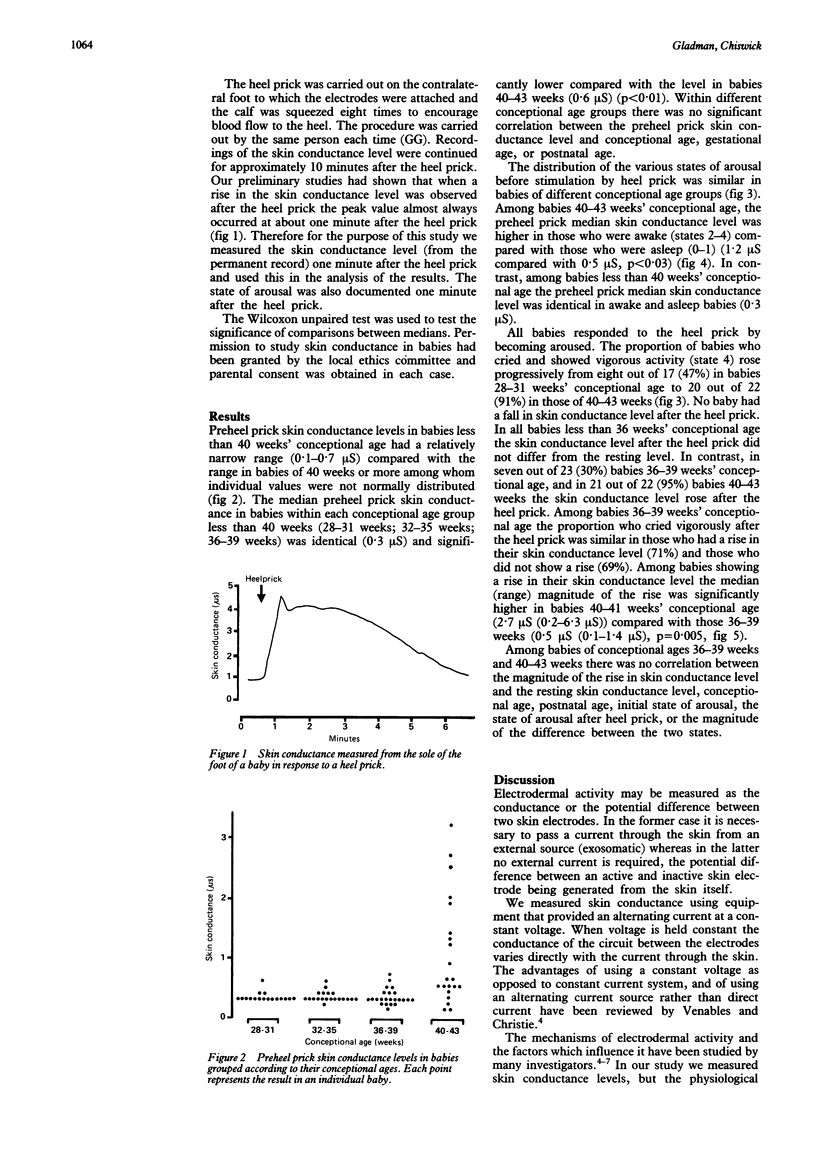Abstract
We measured skin conductance continuously from the sole of a foot in babies of different conceptional ages before, during, and for 10 minutes after a 'heel prick' carried out for routine blood sampling. We studied 82 healthy babies whose gestational and postnatal ages ranged from 25-42 weeks, and 1-73 days. The median skin conductance level (preheel prick) in babies of 40-43 weeks' conceptional age was 0.6 microS (microsiemens) and differed significantly between awake babies (1.2 microS) and those who were asleep (0.5 microS). In contrast babies less than 40 weeks had a significantly lower median skin conductive level (0.3 microS) which was identical in awake and asleep babies. In response to the heel prick all babies became aroused and skin conductance rose sharply and immediately in 21 out of 22 (95%) babies 40-43 weeks' conceptional age, and in seven out of 23 (30%) babies 36-39 weeks. The median rise at one minute in babies of 40-43 weeks was significantly higher than those 36-39 weeks (2.7 microS compared with 0.5 microS). No babies less than 36 weeks had a change in their skin conductance after the heel prick. These results are consistent with the notion that 'emotional sweating' is a function of maturity and does not develop until 36 weeks' conceptional age.
Full text
PDF



Selected References
These references are in PubMed. This may not be the complete list of references from this article.
- Christie M. J. Electrodermal activity in the 1980s: a review. J R Soc Med. 1981 Aug;74(8):616–622. doi: 10.1177/014107688107400812. [DOI] [PMC free article] [PubMed] [Google Scholar]
- Edelberg R. The effects of initial levels of sweat duct filling and skin hydration on electrodermal response amplitude. Psychophysiology. 1983 Sep;20(5):550–557. doi: 10.1111/j.1469-8986.1983.tb03012.x. [DOI] [PubMed] [Google Scholar]
- Fowles D. C., Christie M. J., Edelberg R., Grings W. W., Lykken D. T., Venables P. H. Committee report. Publication recommendations for electrodermal measurements. Psychophysiology. 1981 May;18(3):232–239. doi: 10.1111/j.1469-8986.1981.tb03024.x. [DOI] [PubMed] [Google Scholar]
- Harpin V. A., Rutter N. Development of emotional sweating in the newborn infant. Arch Dis Child. 1982 Sep;57(9):691–695. doi: 10.1136/adc.57.9.691. [DOI] [PMC free article] [PubMed] [Google Scholar]
- LADER M. H., MONTAGU J. D. The psycho-galvanic reflex: a pharmacological study of the peripheral mechanism. J Neurol Neurosurg Psychiatry. 1962 May;25:126–133. doi: 10.1136/jnnp.25.2.126. [DOI] [PMC free article] [PubMed] [Google Scholar]
- Muramatsu K., Hirose S., Yukitake K., Ogata H., Mitsudome A., Oda T. Relationship between maturation of the skin and electrical skin resistance. Pediatr Res. 1987 Jan;21(1):21–24. doi: 10.1203/00006450-198701000-00006. [DOI] [PubMed] [Google Scholar]
- Venables P. H., Martin I. The relation of palmar sweat gland activity to level of skin potential and conductance. Psychophysiology. 1967 Jan;3(3):302–311. doi: 10.1111/j.1469-8986.1967.tb02710.x. [DOI] [PubMed] [Google Scholar]


